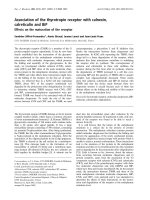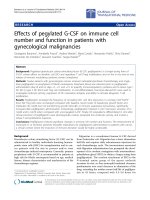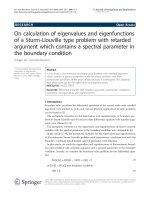Hands on with SAP ERP and IDES
Bạn đang xem bản rút gọn của tài liệu. Xem và tải ngay bản đầy đủ của tài liệu tại đây (8.71 MB, 182 trang )
D.J. SCHENK & C.T. DRAIJER
HANDS-ON WITH SAP
ERP AND IDES
CARRYING OUT A COMPLETE
ERP PROCESS
FOURTH EDITION
Download free eBooks at bookboon.com
2
Hands-on with SAP ERP and IDES: Carrying out a complete ERP process
4th edition
© 2016 D.J. Schenk, C.T. Draijer & bookboon.com
ISBN 978-87-403-1434-2
Download free eBooks at bookboon.com
3
CONTENTS
HANDS-ON WITH SAP ERP AND IDES
CONTENTS
Preface
10
Introduction
11
Study guide
13
Part 1 Enterprise Resource Planning and SAP
14
1
Enterprise Resource Planning
15
1.1
Enterprise Resource Planning software
15
1.2
Enterprise Resource Planning as a follow-up to MRP
17
1.3
Advantages and disadvantages of ERP
17
1.4
Functions of Enterprise Resource Planning
19
1.5
Supply Chain Management
21
1.6
Supply Chain Management and Enterprise Resource Planning
25
www.sylvania.com
We do not reinvent
the wheel we reinvent
light.
Fascinating lighting offers an ininite spectrum of
possibilities: Innovative technologies and new
markets provide both opportunities and challenges.
An environment in which your expertise is in high
demand. Enjoy the supportive working atmosphere
within our global group and beneit from international
career paths. Implement sustainable ideas in close
cooperation with other specialists and contribute to
inluencing our future. Come and join us in reinventing
light every day.
Light is OSRAM
Download free eBooks at bookboon.com
4
Click on the ad to read more
CONTENTS
HANDS-ON WITH SAP ERP AND IDES
2
The Company: SAP AG
27
2.1
The Company: SAP AG
27
2.2
Products of SAP AG
27
3
SAP ERP
30
3.1
Structure of SAP ERP
30
3.2
Analytics
31
3.3
Financials
32
3.4
Human Capital Management
32
3.5
Procurement and Logistics Execution
33
3.6
Product Development and Manufacturing
34
3.7
Sales and Service
35
3.8
Corporate Services
36
4
Organization depicted in SAP ERP
37
4.1
Sorts of data
37
4.2
Organization structure projected in SAP ERP
37
4.3
Projecting the business structure in SAP ERP
40
4.4
SAP hierarchy
40
4.5
Financial (FI)
42
4.6
Material Management (MM)
44
4.7
Sales and Distribution (SD)
45
5
Customizing
52
5.1
Scope of the implementation
52
5.2
The approach to the project
53
5.3
Confusing terminology
54
5.4
Accelerated SAP
55
5.5
Customizing
56
6
SAP Business Suite
57
6.1
SAP Business Suite
57
6.2
NetWeaver
61
6.3
SAP Portal
63
6.4
Collaborative Business
65
7
IDES
67
7.1
Short description of IDES
67
7.2
Structure of IDES sales organization
68
Download free eBooks at bookboon.com
5
CONTENTS
HANDS-ON WITH SAP ERP AND IDES
Part 2 Carrying out a complete ERP process
70
8
Log on and the SAP ERP interface
71
8.1
Client code and company code
71
8.2
User
71
8.3
Logging on
71
8.4
Logging off
72
8.5
Explaining the standard screen
72
8.6
Key to symbols
74
8.7
Exporting lists to Word or Excel
76
8.8
Favourites
77
8.9
Users’ defaults and users’ parameters
77
8.10
Variant
78
9
Accounts receivable
79
9.1
Open Items
79
9.2
Customer master data
81
10
General Ledger administration
86
10.1
General ledger account master data
86
10.2
Balance sheet and profit and loss statement
88
11
Accounts payable
89
11.1
Invoice processing C-Business diagram
89
11.2
Vendor master data
89
11.3
Post the invoice
90
11.4
Monitoring the accounts payable
92
11.5
Payment to a vendor
93
12
Human resources
94
12.1
Position
94
12.2
Hiring a new employee
96
13
Logistic master data
99
13.1
Master data for the materials
99
13.2
Bill of material
107
13.3
Direct wage hours and machine hours
108
13.4
Work center
109
13.5
Routing
110
13.6
Info record
111
Download free eBooks at bookboon.com
6
HANDS-ON WITH SAP ERP AND IDES
CONTENTS
14
Complete ERP process
112
14.1
General
112
14.2
C-Business logistics diagram
112
14.3
Sales call to the customer
113
14.4
Create a quotation for a customer
114
14.5
Create a customer order
115
14.6
The stock/requirements list
116
14.7
Requirements planning (MRP)
116
14.8
Create a purchase order for the supplier
117
14.9
Goods receipt from a supplier
120
14.10
Transfer order goods receipt to permanent storage
120
14.11
Receipt of the invoice from the supplier
121
14.12
Payment of the supplier’s invoice
122
14.13
Production order
122
14.14
Issue of raw materials to production
123
14.15
Confirmation of a production order
125
14.16
Goods receipt finished product from production
125
14.17
Creating a delivery to the customer
126
14.18
The document flow around the sales order
126
14.19
Picking the delivery
127
14.20
Goods issue delivery to the customer
127
14.21
Invoice the customer
127
14.22
Incoming payment from the customer
128
14.23
Tracking and tracing
129
Part 3 Special applications
130
15
Fixed assets
131
15.1
C business diagram acquisition of fixed assets scenario
131
15.2
Asset overviews
131
15.3
Capitalizing the asset
132
15.4
Registering the purchase
133
15.5
Post the payment
133
15.6
Asset explorer
134
15.7
Depreciation
135
16
Repair order
136
16.1
C-business diagram internal order processing
136
16.2
Creating profit center
137
16.3
Creating cost centers
137
Download free eBooks at bookboon.com
7
HANDS-ON WITH SAP ERP AND IDES
CONTENTS
16.4
Creating an internal order
138
16.5
Ordering materials for internal use
139
16.6
Goods receipt for internal use
140
16.7
Invoice receipt material internal use
141
16.8
Activity output/prices
142
16.9
Internal activity settlement
142
16.10
Reporting actual items
143
17
Production on stock and forecast based planning
144
17.1
Production on stock and forecast based planning
145
17.2
Master data change and extension
145
17.3
Demand management
146
17.4
Forecast based planning
147
17.5
Production planning
148
17.6
Create a purchase order for the supplier
149
17.7
Goods receipt from a supplier
149
17.8
Transfer order goods receipt to permanent storage
149
17.9
Receipt of the invoice from the supplier
149
17.10
Payment of the supplier’s invoice
149
17.11
Production order
150
17.12
Issue of raw materials to production
150
17.13
Confirmation of a production order
150
17.14
Goods receipt finished product from production
150
17.15
Sales from stock
150
17.16
Making a delivery to the customer
151
17.17
Picking the delivery
151
17.18
Goods issue delivery to the customer
151
17.19
Invoice the customer
151
17.20
Incoming payment from the customer
151
17.21
Analyses
151
18
Product Costing
152
18.1
Cost of goods manufactured
152
18.2
Overhead costs
153
18.3
Cost of goods sold
155
18.4
Stock valuation at costs of goods manufactured
156
18.5
Production order using product costing
157
18.6
Create a purchase order at the supplier
158
18.7
Goods receipt from the supplier
158
18.8
Transfer order goods receipt to permanent storage location
158
Download free eBooks at bookboon.com
8
HANDS-ON WITH SAP ERP AND IDES
CONTENTS
18.9
Invoice receipt from the supplier
158
18.10
Production order release
159
18.11
Issue of raw materials to production
159
18.12
Production order confirmation
159
18.13
Goods receipt finished product from production
160
18.14
Planned and actual costs production order
160
18.15
Actual overhead
160
18.16
Variance analysis production
161
18.17
Settlement of production order
161
18.18
Overview of planned and actual cost production order
162
19
Human Resource Management
163
19.1
Position
163
19.2
Advertisement
164
19.3
Applicant
165
19.4
Selection applicant
167
19.5
Hiring applicant
167
19.6
CATS
169
19.7
Succession planning
170
FAQ
171
Index
181
Download free eBooks at bookboon.com
9
PREFACE
HANDS-ON WITH SAP ERP AND IDES
PREFACE
he material for this module was based on the exercises with the Vulcan project of the
University of Würzburg and scenarios as described for SAP’s model business IDES.
In June 2000 an upgrade took place of the SAP ERP system and of the course book
accompanying the 4.6b version of SAP ERP. In July 2001 the course book was revised and
modiied as version 4.5.c.
In July 2002 some minor updates were made as result of feedback from users of the syllabus.
We greatly appreciate the cooperation and contribution of Bernhard van Dijk, Sandra de
Hoog and Andy Lay. We thank Michael Egmont-Petersen and Johan Versendaal of the
Institute of Information and Computing Sciences, Utrecht University, for their contribution
to this book.
In July 2006 the material was revised and modiied as version SAP ERP 2004 IDES.
In May 2009 the material was extended, revised and modiied as version SAP ERP 5.0 IDES.
Spring 2013 a lot chapters have been improved, like human resource management and the
more detailed calculation of production costs. We thank Jan van der Belt, VU University, and
Colm O’Flynn, HvA. Special thanks go to Arnold Caris as co-author of the previous editions.
Spring 2016 FAQ are added, errors are corrected and an update to SAP GUI 7.4.
Amsterdam, 13 June 2016
Dirk-Jan Schenk
Casper Draijer
Download free eBooks at bookboon.com
10
INTRODUCTION
HANDS-ON WITH SAP ERP AND IDES
INTRODUCTION
Information within large companies (multinationals) is usually extracted from separate
registration systems which support speciic business functions such as production planning,
warehousing, inancial accounting and personnel administration.
Many companies wish to integrate their business processes. Process integration relects
the change from a functional organisation towards a process oriented organisation. he
integration is not only within the company, but also beyond the borders of the organisation.
he external process integration with customers and vendors uses Customer Relationship
Management and Supplier Relationship Management. he cooperation with other companies
is done with Supply Chain Management and Product Lifecycle Management.
Enterprise Resource Planning (ERP) integrates logistics, inancial and human resources in
one system. (See Figure A)
Figure A ERP system and disciplines
SAP ERP is a software system developed by the SAP AG that covers almost all transaction
requirements and business functions of a company. For speciic branches such as the airline
industry, health care, the chemical industry and the retail industry, within SAP ERP the
so-called Industry Solutions can be activated.
With the introduction of SAP Business Suite the SAP ERP system is extended with a
Customer Relations Management system (CRM), Supplier Relationship Management
(SRM), Product Lifecycle Management (PLM), Supply Chain Management (SCM), Strategic
Enterprise Management (SEM) based on the Business Warehouse (BW). NetWeaver enables
the integration between the components and other administration and production control
systems. A portal enables users to activate all the systems with a single logon.
Download free eBooks at bookboon.com
11
INTRODUCTION
HANDS-ON WITH SAP ERP AND IDES
IDES, the International Demonstration and Evaluation System, has been developed by SAP.
IDES provides a huge data base which enables the simulation of many diferent business
scenarios within the SAP systems. Many business scenarios are described in the IDES help
application. he IDES system is used worldwide by SAP for training purposes.
his course is an introduction to ERP supported by SAP, SAP ERP and IDES.
he method has been developed for use in business schools and universities. Knowledge of
the subjects related to ERP is assumed.
he method is not focusing on the diferent modules of SAP ERP, but on the main
characteristic of SAP ERP: the integration of business processes.
he course is divided into three parts:
Part 1 Enterprise Resource Planning and SAP.
Part 2 Carrying out a complete ERP process.
Part 3 Special applications.
Part one, Enterprise Resource Planning and SAP, deals with Enterprise Resource Planning
and the company, SAP AG, which developed the SAP systems. he technical aspects of the
SAP ERP system are illustrated and a description of SAP is given.
Part two focuses on a complete ERP process. he assignments in the chapters deal with
logistics, inancial and human resources. Each chapter starts with a short introduction and
a process outline.
In chapter 14 a sales order-driven process is presented. By means of material requirements
planning (MRP I) all steps of the business cycle are carried out and are ofering experiences
typical for working with ERP and SAP ERP. he data of chapters 9-13 are applied in this
ERP process.
In part three, special applications such as ixed assets, controlling, product costing, production
on stock with forecast based planning and human resource management are introduced.
Download free eBooks at bookboon.com
12
STUDY GUIDE
HANDS-ON WITH SAP ERP AND IDES
STUDY GUIDE
Indication of hours needed by students to carry out the assignments:
Chapters 9, 10, 11, 12, 13: 1.5 hours per chapter.
Chapter 14: 8 hours.
A next level for Finance is in the chapters 15, 16 and 17.
More about Logistics can be found in chapter 15.
For HRM more details are in chapter 19.
he description of the assignments and carrying them out give answers to all kind of
questions regarding the use of an ERP system. For example: How can a product be
created? How is a purchase order executed and which inancial documents are created?
How is a production order created and when will the inished product be delivered? How
is a warehouse organized? How are orders delivered to customers? Which master data are
necessary to perform an MRP run?
he relevance of the exercises for the diferent subjects and competences are summarized
in Figure A.
he assignments in this book are presented concisely in such a way as to allow this course to
be integrated into courses based on various didactical insights: from self-study to theoretical
lectures and guided completion of the exercises.
Download free eBooks at bookboon.com
13
HANDS-ON WITH SAP ERP AND IDES
PART 1 ENTERPRISE RESOURCE PLANNING AND SAP
PART 1
ENTERPRISE RESOURCE PLANNING
AND SAP
1.
2.
3.
4.
5.
6.
7.
Enterprise Resource Planning
he Company: SAP AG
SAP ERP
Organization depicted in SAP ERP
Customizing
SAP Business Suite
IDES
In part one, Enterprise Resource Planning and SAP, chapter 1 contains a description of
enterprise resource planning in general.
he company that developed SAP ERP, SAP AG, will be introduced in chapter 2.
In chapter 3 an overview of the functionality of SAP ERP is given.
he depiction of the organization of a company in the system will be explained in chapter 4.
his and other adaptations of SAP ERP to the company can be found at customizing, which
can be found in chapter 4.
Chapter 6 deals with the SAP Business Suite.
he IDES environment is described in chapter 6.
Download free eBooks at bookboon.com
14
ENTERPRISE RESOURCE PLANNING
HANDS-ON WITH SAP ERP AND IDES
1
ENTERPRISE RESOURCE
PLANNING
Enterprise Resource Planning software will be explained in this chapter. Attention is given
to the advantages and disadvantages of ERP software. Enterprise Resource Planning can be
considered as follow-up development coming out of Material Resource Planning.
he functions of Enterprise Resource Planning are presented in a diagram and are explained
in the text. he low of goods and the transformations they may undergo are explained in
paragraph 1.4. In paragraph 1.6 the low of goods is linked with Enterprise Resource Planning.
1.1
ENTERPRISE RESOURCE PLANNING SOFTWARE
Enterprise Resource Planning software (ERP software) can be deined as software supporting
the whole range of operations by processing the information associated with goods lows
and inancial lows.
360°
thinking
.
Discover the truth at www.deloitte.ca/careers
Download free eBooks at bookboon.com
15
© Deloitte & Touche LLP and affiliated entities.
Click on the ad to read more
ENTERPRISE RESOURCE PLANNING
HANDS-ON WITH SAP ERP AND IDES
ERP software above all has an important added value since it facilitates integrated recording
of information throughout the organization. he information kept on record by an
organization is generic to a signiicant extent and can therefore easily be accommodated
within a standard package.
In the past, each department installed its own computer system. he personnel department
used a personnel management system, the inancial administration an accounting package,
while several planning and warehouse systems were in use in the production department.
he separate systems often worked to the complete satisfaction of departmental users, but
the links between these systems led to many problems, high cost levels and poor lexibility.
An integrated ERP package ofers a solution to this problem.
Figure 1.1 Enterprise Resource Planning in SAP ERP
A large production company will be able in general to get by with a system for oice
automation (e.g. MSOice), an ERP package (for example SAP ERP) and some highly
specialized software in the ield of process automation (for example CAD/CAM systems).
he development of ERP software is a booming business. he wealth of advertisements and
job recruitment sites like www.monsterboard.nl in publications specializing in computer
and information specialist recruitment indicates a great demand for SAP consultants, Baan
experts, etc.
SAP (SAP ERP and R/3) was in 2013 with a market share of 26% still the market leader.
Oracle, who took over Peoplesoft and JD Edwards, is number two.
Download free eBooks at bookboon.com
16
ENTERPRISE RESOURCE PLANNING
HANDS-ON WITH SAP ERP AND IDES
ERP systems attempt to ofer a fully integrated solution for the management of inancial
lows, goods lows and information lows within organizations. Many ERP systems have their
roots in production planning. his is sometimes apparent from the fact that the production
module is signiicantly better developed than the other modules. he original nature of the
production (discrete vs. process industry) often has a distinct impact over contemporary
software. Baan and BPCS for instance come from the discrete industry sector, in which
the emphasis lies on bills of materials management and material requisition planning. SAP
originally comes from the inancial sector and has consequently developed functionality
features centred on production and logistics. Nearly all the large players in the market are
converging with respect to functionality of the ERP package. Meanwhile SAP and Baan
have process modules designed to support the process industry.
1.2
ENTERPRISE RESOURCE PLANNING AS A FOLLOW-UP TO MRP
ERP is also seen as a supplement to MRP II. In the Material Requirements Planning concept
(MRP I) a demand forecast is drawn up on the basis of bills of materials, calculated according
to range of production orders and purchasing orders expected. Manufacturing Resource
Planning (MRP II) was a later extension. his concept represents an expansion of MRP I
into a more integrated planning and management concept. MRP II for instance also takes
into account the available production capacities. MRP I and MRP II are compatible for
use within a single organization. Increasingly far-reaching internationalization means that
management must take place ‘over the heads of individual plants’. Mutual deliveries between
organizational units are included in the concept, for instance. ERP is compatible with this.
he functionality of ERP software has been drastically expanded over recent years to include
Customer Relation Management (CRM), sales support, supply chain management, worklow
management, human resources management, etc. his trend continues; ERP software is
further expanding its borders. Nearly all operational functions are now supported.
1.3
ADVANTAGES AND DISADVANTAGES OF ERP
Some of the advantages have already been discussed above. he most important of these are:
• Integration: the coherence between processes is seamlessly supported. Island automation
is no longer an issue. Integration reduces problems caused by redundancy and
errors in the data.
• Process orientation: instead of supporting activities in departments, ERP orientates
itself towards operational processes that take place throughout the whole of the
organization (and outside it), and indeed you see this in so-called Worklow
Management solutions that the ERP systems ofer. hese cater to the support and
direction of operational processes.
Download free eBooks at bookboon.com
17
ENTERPRISE RESOURCE PLANNING
HANDS-ON WITH SAP ERP AND IDES
• Openness: ERP systems can communicate with other systems; this means that the
Supply Chain concept, a far-reaching chain integration into the industrial process,
can be utilized. ERP systems can also communicate with other systems, such as
Customer Relationship Management software (CRM).
• State-of-the-art: the research being carried out by ERP suppliers is suiciently
comprehensive to ensure that a company using an ERP system can be conident that
the functionality will both continue to be available and continue to be expanded.
Associations of users often have some inluence on aspects of functionality earmarked
for expansion or improvement.
• Industrial sector orientation: ERP suppliers ensure that their software supports
various sectors of industry. his support (called Industry Solutions) is constantly
being expanded.
• Internationalization: ERP can be used supra-locational, supra-organizational and
beyond national borders. his is an ideal solution for multinationals, since data
taken from all their subsidiaries needs to be consolidated.
ERP is not a universal panacea. Naturally there are some disadvantages to the introduction
of a system such as this. You might like to consider the following, for instance:
• High costs: the price of the software license is fairly high. he consultancy costs
involved in the implementation of an ERP package exceed the license cost by a
factor of approximately 2–4. A Dutch theme park, for instance, recently implemented
an ERP system at a cost of about €3.5 million, of which €0.5 million was for the
software license.
• Lengthy implementation: the time taken for making enhancements, customizing and
the implementation often exceeds a year. Accelerated implementation techniques,
Accelerated SAP, are available however, under which a selection is made of best
practices in the implementation, where the need for labour-intensive ine tuning
of the software is partly eliminated. In this case processes in the organization (as
regards its operational processes) are adapted to the software. A solution like this is
welcomed particularly by smaller organizations. In the case of medium and small
companies, an implementation of this kind takes something in the order of 3 to
6 months, depending on the complexity involved.
• No tailor-made solution: ERP remains a standard solution: the user may have to
modify his expectations as far as his package of requirements is concerned. Tailor-made
systems are generally much more expensive than standard software. Modiications
made to standard software are costly and can cause problems with upgrades. For
that reason it becomes the policy of some companies to avoid modiications during
the implementation.
Download free eBooks at bookboon.com
18
ENTERPRISE RESOURCE PLANNING
HANDS-ON WITH SAP ERP AND IDES
Since the 1990s we have seen more organizations transferring to standard software. On the one
hand, each company is individually aware of its own unique operational processes, yet these
unique points are often remnants from the past. here is something to be said for taking a
look to see whether the best practice options, which ERP systems ofer, are not in fact better
than one’s own solutions. Why should my organization difer from the many other companies
in my sector that have already been studied? Moreover, are my (unique) deviations from the
general pattern as regards operational processes really as necessary as I think they are?
he employee learning period for new functionality in an ERP package is, as a matter of
fact, generally much shorter than in cases where a totally new software package is acquired.
1.4
FUNCTIONS OF ENTERPRISE RESOURCE PLANNING
Figure 1.2 shows the most important functions that can be used by an ERP system in
corporate operations. In this overview, the supporting functions are grouped around the
logistics, the primary processes. he central feature is the low of goods from the supplier
to the customer: procurement results in the receipt and storage of raw materials (triangle),
the various raw materials are processed during production into inished product units;
these are subsequently delivered to the customer from stock. he way in which content is
given to the primary processes of procurement, sales, stock control, shop loor control and
manufacturing, is market and product speciic. he low of goods from the supplier to the
customer is counterbalanced by a cash low in the opposite direction: from the customer
to the supplier. Recording of this cash low takes place in the accounts receivable (AR) and
accounts payable (AP) sub-administrations and in the ledger administration (general ledger).
Figure 1.2 Enterprise Resource Planning
Download free eBooks at bookboon.com
19
ENTERPRISE RESOURCE PLANNING
HANDS-ON WITH SAP ERP AND IDES
he relationship between the low of goods and the cash low constitutes the value cycle
of an organization. he non-shaded functions form the secondary, supporting activities.
Treasury, asset management and consolidation support the management and planning of
inancial resources over the short and long term. Worklow management, planning and
control, human resources, service management and customer relations management support
the logistics processes.
In Figure 1.3 the central focus is on the low of goods. he planning levels and logistic
modules are shown.
Figure 1.3 Integrated planning
Download free eBooks at bookboon.com
20
ENTERPRISE RESOURCE PLANNING
HANDS-ON WITH SAP ERP AND IDES
In sales and distribution (SD) the sales statistics for the previous year form the basis for
establishing a sales forecast for the coming year. his sales forecast makes up the demand
for production capacity. By gearing the availability of capacity to sales demand, provision is
made for the necessary capacity within the production planning (PP) by establishing both
the nominative capacity and the expected annual capacity (year capacity plan and capacity
allocation). he planning of the annual capacity constitutes the basis for establishing the
main production plan within PP, as well as the basis for setting up the necessary procurement
within Materials Management (MM). he master production plan has a planning horizon
of one year and consists of production objectives relating to product units per period.
he master production plan thereby creates a procurement requirement for raw materials/
components. his requirement is met by establishing a procurement plan. he master
production plan is converted into a detailed production plan, with a planning horizon of
less than one year. he planning quantities are the number of units to be produced and the
number of production orders. Even at this level, sales igures are coordinated according to
production objectives and procurement. he planned production orders are converted into
actual production orders, raw materials/components are issued and processed into inished
products. he inished products are made available for delivery to the customer by MM.
he planning for distribution to customers, which is also factored into this, takes place
from within sales and distribution, SD.
he Supply Chain concept is central in SAP ERP: the chain from the original supplier to
the inal consumer has to be managed. By bringing optimum co-ordination to the low of
information, the low of goods and the cash low, a maximum customer response is achieved
at minimum cost according to SAP. It is possible for a customer, to gain information from
the Internet regarding the products of a particular company, to adapt your own products
accordingly and to place an order. his order then automatically ends up in SAP ERP;
where necessary, this package automatically generates orders to suppliers (multi-company
planning) and even initiates the necessary processes within the organization of a company.
In this way, open systems can be linked to each other and transactions extended over various
individual companies.
1.5
SUPPLY CHAIN MANAGEMENT
he Supply Chain comprises all activities that have to do with the low of goods and the
transformations they may undergo, all the way from raw materials through to the end user,
complete with the associated information lows (see Figure 1.4).
Download free eBooks at bookboon.com
21
ENTERPRISE RESOURCE PLANNING
HANDS-ON WITH SAP ERP AND IDES
Figure 1.4 Chain from supplier to consumer
We are concerned here in fact with the activities that take place within the manufacturing
process. In the case of simple products, this supply chain can readily be identiied and
surveyed, but when you think of the automobile industry, for instance, the situation is
very complex.
Supply Chain Management (SCM) is therefore the control and integration of these activities
by making use of all kinds of cross connections and networks in order to achieve a signiicant
competitive advantage. he chain goes upstream in a supplier network and downstream in a
distribution network (customers). he supplier network consists of all the companies that
provide an input in any way whatsoever; these inputs could be physical raw materials,
but they could also be information, for instance. In the case of the automobile industry,
this chain would represent a supplier network of thousands of companies supplying goods
ranging from steel and plastics, but also including complete gearboxes, brake systems, car
radios and similar. Even the production of these gearboxes etc. is part of the supply chain.
Some authors say that when looking for the start of a supply chain you always come back
to Mother Earth. he main point, however, is that each supply chain consists of a (generally
large) series of linked suppliers and customers; each customer becomes a supplier in the
next link of the supply chain until the product reaches the end user.
Seen from within an individual company, you can say that the three SCM perspectives are:
1. internal functions (transforming inputs into outputs);
2. upstream supplier functions;
3. downstream customer functions.
Download free eBooks at bookboon.com
22
ENTERPRISE RESOURCE PLANNING
HANDS-ON WITH SAP ERP AND IDES
he management challenge is that coordination takes place between these three aspects in
such a way that the company maintains its right to exist within the supply chain.
1. Internal functions
Where the internal functions are concerned, these relate to various operational processes,
including the transformation processes of raw materials or semimanufactures into inished
products. hese raw materials or semi-manufactures are supplied by the suppliers and
the inished products are supplied to the distribution channel (the dealer organization
in the case of the automobile industry). Orders from purchasers of automobiles must be
translated into production orders. It is easy to imagine for instance that in the case of
large freight lorries (as with DAF), this takes place on a one-to-one basis. Each customer
order = one production order = one freight lorry. Even with private vehicles, things are
beginning to move in the direction of production on demand. On deciding to purchase a
new car, for instance, you can now specify the version, the colour and whether it should
have air-conditioning, etc. he inluence of the inal consumer over the production is
steadily increasing.
he sales order data are very detailed: quotation prices, latest possible delivery dates,
delivery scenarios, etc. Production planning is also extremely important. Use can be made
of MRP here.
2. Upstream supplier functions
his refers to functions that take place outside the individual organization. Upstream is
the procurement function. You think here of the selection of suppliers who can meet our
requirements and wishes and who are reliable when it comes to delivery. he maintenance
of good relations with suppliers is extremely important. In SCM, you see contacts with
suppliers fanning out into the product development, commercial oice, warehouse and
administration departments and so on.
In this situation, there is close contact with the suppliers from within the internal
operational processes.
Download free eBooks at bookboon.com
23




![.EI-JEMENTARY LESSONS IN LOGIC..ELEMENTARY LESSONSIN LOGIC:DEDUCTIVE AND INDUCTIVE.WITH COPIOUS QUESTIONS AND EXAMPLES.ANDA VOCABULARY OF LOGICAL TERMS.BYw.,../STANLEY ]EVONS, M.A.PROFESSOR OF LOGIC IN OWENS COLLEGE, MANCHESTElLNEW EDI pdf](https://media.store123doc.com/images/document/14/rc/vq/medium_paXnfMlcyQ.jpg)


![hands-on guide to the red hat exams elektronisk ressurs rhsca [i.e. rhcsa] and rhce cert guide and lab manual](https://media.store123doc.com/images/document/14/y/db/medium_jnzWdahMg2.jpg)

